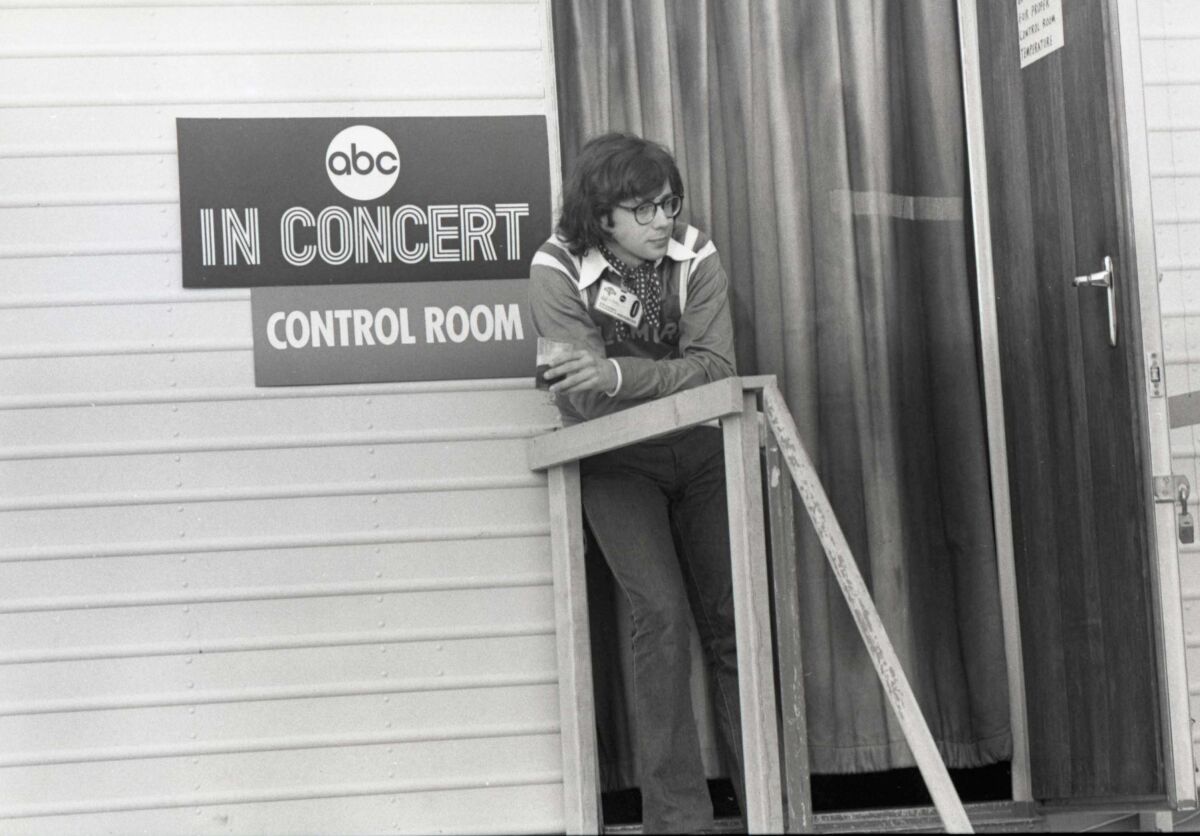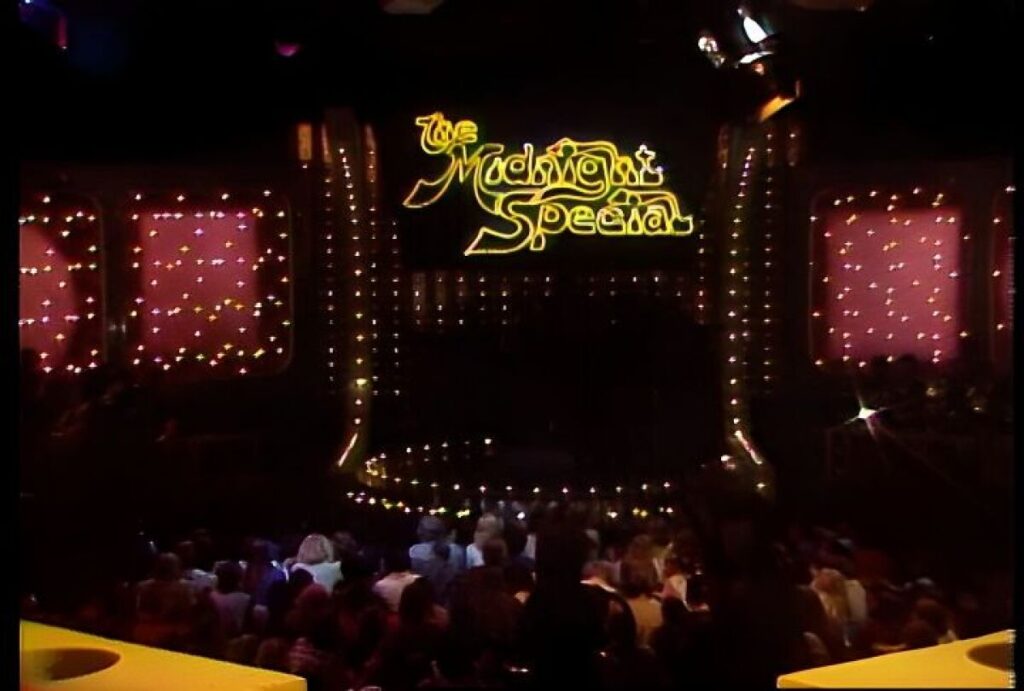Through the first few decades of television, the last piece of music late-night viewers heard was “The Star-Spangled Banner” before a station signed off.
That changed thanks in large part to Burt Sugarman, an independent producer of game shows, music specials and eventually movies, who believed people would stay up after Johnny Carson’s “Tonight” show if there were something to actually watch. He proved it 50 years ago when he launched NBC’s Friday night music series “The Midnight Special” that featured dozens of major rock, pop, country and soul acts of the 1970s.
Sugarman — now 84 and often seen seated behind the plate at Dodger Stadium next to his wife Mary Hart of “Entertainment Tonight” fame — knew his weekly program was worth preserving (along with the contracts that gave him control of the rights). After making the performances available on cable network VH-1 and on DVDs over the decades, he’s finally brought them online, to a dedicated YouTube channel he introduced last month.
“Many of the artists we featured on ‘The Midnight Special’ back in the ’70s are touring again — both domestically and internationally, playing all types of venues, including arenas and stadiums,” Sugarman said in a recent interview. “It felt like the right time to introduce new audiences to the show.”
Sugarman’s vault offers a bounty of enduring artists, including Fleetwood Mac at the height of the band’s powers, Dolly Parton during her breakthrough crossover from country to pop, and Linda Ronstadt before and after “Heart Like a Wheel” propelled her to super stardom. Elton John, Tina Turner, Led Zeppelin, Aretha Franklin, KISS, Johnny Cash, Sly and the Family Stone, Roxy Music, Todd Rundgren, Electric Light Orchestra, the Spinners, Heart and Donna Summer all performed live on the show throughout the years, along with top comedians such as Steve Martin and Richard Pryor.
“Midnight Special” also featured TV rarities such as progressive rockers King Crimson (“Larks’ Tongues in Aspic” fans rejoice!), a live performance from Steely Dan, and unlikely combinations such as the Bee Gees and R&B legend Wilson Pickett teaming up on “Hey Jude.” Clips of David Bowie’s final performance of his 1980 show at the Marquee Club in London are offered, including his duet with Marianne Faithfull on “I Got You Babe.”
Sugarman is adding clips each week to the YouTube channel and promises entire 90-minute shows as well, which haven’t been seen in full since they first aired on NBC.
“The Midnight Special” was part of a mini-wave of late-night rock-music TV shows in the early 1970s that also included ABC’s “In Concert” and the syndicated “Don Kirshner’s Rock Concert.” While network TV executives were wary of the music and the drug culture surrounding it at the time, they could still count: They saw the drawing power of rock festivals and concerts that proliferated after Woodstock.
The shows came along in the three-network era preceding the emergence of cable and MTV, when choices for watching music on TV were slim. Fans had to settle for Dick Clark’s “American Bandstand” on ABC and the syndicated “Soul Train,” which both featured artists lip-syncing their hit records.
The other options were network TV variety shows such as “The Red Skelton Hour,” on which the Rolling Stones made their first U.S. TV appearance in 1964. Many artists dreaded playing them in the 1970s, when credibility with the youth audience became a must.
“They were so controlling of your image,” Ronstadt said in a phone interview. “If you did the Glen Campbell show, they gave you dresses to wear. It didn’t go down so well with me. On some shows you would have to follow plate twirlers or an act with an orangutan.”
But Ronstadt’s biggest complaint about TV was how the music sounded. “The shows made their own arrangements and load it up with lard,” she said. “Your audio and video were totally out of your control.”
Sugarman addressed that concern by creating a show on which acts played live with their own instruments and arrangements in a concert-like setting. He was convinced young people coming home from a Friday night out would stay up for it. In 1972, he brought the idea to executives at NBC, who scoffed at first.
“They said, ‘You know these rock ’n’ roll people, they’re full of drugs. They’re not going to show up and it’ll just be it’ll be a waste of money,’” Sugarman recalled. “So I said, ‘Well what if I pay for it?’”
Along with picking up the tab for the production, Sugarman also promised the artists on the program would promote voter registration, as the voting age was lowered from 21 to 18 before the 1972 presidential election. With no financial risk involved and a public service rationale attached, NBC gave the producer a green light.
Sugarman bought the time from NBC and wrangled the program’s advertisers himself. He pitched a General Motors executive named John DeLorean, who loved the idea of reaching young viewers who could influence their parents’ buying decisions and signed the company on.
The set of Burt Sugarman’s “The Midnight Special.”
(Burt Sugarman)
When Sugarman was shopping for acts, his friend, impresario Jerry Weintraub, sold him on John Denver, then a wholesome folkie type who had yet to become a multi-platinum star. Sugarman had never heard of Denver, but sensed the singer would allay NBC’s concerns about druggie rock stars and made him the host of the pilot.
“He seemed like a clean-cut guy who would show up,” Sugarman recalled.
Once “The Midnight Special” was on track, Sugarman got the support of Carson, who was his neighbor and regular tennis partner in Beverly Hills. The “Tonight” host wasn’t a fan of rock music, but liked the idea of having a program to follow him at 1 a.m., as it would keep viewers tuned in through the end of his show, which ran 90 minutes at the time. Carson plugged “The Midnight Special” on the air before its launch.

Burt Sugarman, left, with Paul Anka on the set of NBC’s “The Midnight Special.”
(Burt Sugarman)
The pilot episode aired on Aug. 19, 1972, with Denver presenting a lineup that included Ronstadt, Mama Cass, the Everly Brothers, David Clayton-Thomas, Argent, War and the Isley Brothers. Sugarman used several soundstages simultaneously on NBC’s Burbank lot, so one act could start after another finished without a time-consuming setup.
The producer’s hunch that people would watch was correct. Around 6 million viewers tuned in to the pilot and NBC picked up “The Midnight Special” as a 90-minute weekly series, launching on Feb. 2, 1973, in the 1 a.m. time slot.
By the time “The Midnight Special” went to series, it already had competition from ABC, which debuted “In Concert” as part of its late-night lineup in September 1972. Its first producer was Don Kirshner, the music publishing executive and producer responsible for made-for-TV groups the Monkees and the Archies.
The launch of “In Concert” was fraught, according to Joshua White, who produced and directed many of the episodes. ABC’s Cincinnati affiliate, outraged over a performance by shock rocker Alice Cooper, pulled “In Concert” off the air mid-show. One station delayed the 11:30 p.m. broadcast to 1:30 a.m.
Even Kirshner, never a cutting-edge figure in the music industry, grew frustrated with anxious ABC executives who interfered with the program. He went out on his own to launch his syndicated “Rock Concert” series that ran for eight years.

Joshua White produced and directed “In Concert” for ABC in the 1970s.
(Joshua White)
Known in the music business for his Joshua Light Show presentations, White went to work at “In Concert” in his green and yellow usher jersey from the Fillmore East, the famous New York rock palace, just to create a level of comfort for the performers who distrusted the medium.
“They were hostile to television,” White said. “They thought people weren’t going to come to concerts anymore.”
But once “The Midnight Special” established itself, Sugarman said he had no problem booking stars to appear. Record companies would see a sales lift the weekend after their acts appeared on the program. Not only did the labels say yes, they always made sure the artists made it to the studio on time.
Starting in the program’s second season, NBC lined up FM stations across the country to simulcast “The Midnight Special,” so viewers could listen on their stereo systems rather than a small mono speaker on a TV set.
White said he envied Sugarman’s efficiency in making “The Midnight Special” and the way the producer was able to balance middle-of-the-road hosts such as Helen Reddy with announcer Wolfman Jack, the gravelly-voiced border radio disc jockey whose status as a pop culture icon rose after his appearance in the George Lucas film “American Graffiti.”
“They used Wolfman Jack, who was authentic,” White said. “He helped ground it. Those soundstages were wonderful. And they did good mixes.”
Sugarman produced 48 weekly episodes a year, making repeats scant on the network. “The Midnight Special” ended in 1981, but the producer, who went on to earn an Oscar nomination for making “Children of a Lesser God,” kept the rights to the show, even turning down a hefty financial offer from Microsoft co-founder Paul Allen.
Sugarman transferred the 2-inch tape masters to 1-inch tape as the technology changed and later converted them to digital files, keeping them in pristine condition over the decades. (White said ABC was still reusing video tape in the 1970s and erased most of the “In Concert” performances.)
Sugarman has previously made clips available to artists who requested them for their Rock & Roll Hall of Fame inductions and pirated copies have long shown up online.
But his YouTube channel is the first authorized online presentation of the shows that will reach a generation of viewers who grew up with on-demand streaming. They will never know what it was like to stay up late to get a glimpse of their favorite artists performing on TV.
“My 31-year-old son still doesn’t get it,” said Sugarman.

